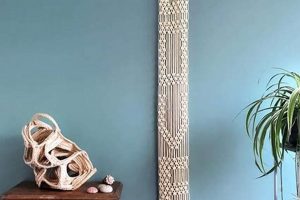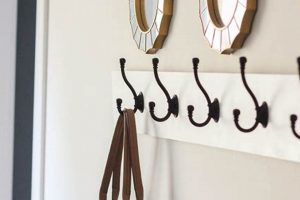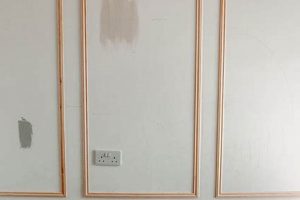A creatively arranged assortment of images, typically personal photographs, displayed on a wall space, often assembled and curated by the individual. It represents a personalized art installation. As an example, consider a home decorator who utilizes family vacation snapshots and vintage postcards to create a visual narrative on a living room wall.
This form of interior decoration offers a means of personal expression, allowing individuals to showcase memories and aesthetics in a highly visible manner. The process fosters creativity and provides a unique and engaging focal point within a room. Historically, displaying pictures in this manner offered an accessible alternative to traditional framed art, democratizing the practice of visual display and enabling customization based on personal resources and preferences.
The subsequent discussion will delve into practical considerations for constructing this type of visual display, encompassing aspects such as layout strategies, material selection, and installation techniques to optimize the visual impact and longevity of the arrangement.
Assembly Advice
The creation of a personalized photographic display requires careful planning and execution to ensure a cohesive and visually appealing final product. Attention to detail in the planning and execution stages will result in a more satisfying and impactful aesthetic.
Tip 1: Curate Images Thoughtfully: Select photographs that share a common theme, color palette, or emotional tone. A unified collection provides a more sophisticated and intentional visual impact. For instance, a wall showcasing only black and white images of architectural details creates a sense of refined consistency.
Tip 2: Plan the Layout in Advance: Before affixing anything to the wall, arrange the photos on the floor or create a digital mock-up. This allows for experimentation with different arrangements and avoids unnecessary holes. Consider symmetry, asymmetry, or a more free-flowing organic design.
Tip 3: Utilize Consistent Framing or Mounting: Maintain consistency in the type of frames used or opt for frameless mounting options with similar hardware. Inconsistency can disrupt the visual flow. For example, employing all identical black frames or using uniform clipboards establishes a sense of order.
Tip 4: Maintain Consistent Spacing: Consistent spacing between the images enhances the overall aesthetic. Measure the distance between each frame and use a level to ensure uniformity. A spacing of two to three inches often provides a clean and balanced look.
Tip 5: Consider Wall Color and Texture: The wall color and texture will impact the overall effect. A neutral-colored wall provides a versatile backdrop, while a textured wall adds visual interest. Dark walls can create a dramatic contrast with lighter images, whereas light walls may enhance the luminosity of brighter photographs.
Tip 6: Ensure Secure Mounting: Utilize appropriate hanging hardware based on the size and weight of the frames. Avoid using adhesives that could damage the wall or the photographs. Picture hanging strips, nails with hooks, or wire systems are viable options.
Tip 7: Incorporate Variety with Caution: While variety can add visual interest, it’s crucial to maintain a balance. Introduce non-photographic elements like small mirrors or decorative objects sparingly to complement rather than overwhelm the photographic display. An example of this is incorporating botanical elements or small art pieces.
Adherence to these guidelines can elevate a simple collection of images into a professionally styled and aesthetically pleasing presentation. Careful planning and execution are key to achieving a polished and enduring result.
The following section will address various styles and thematic approaches that can be employed to further personalize and refine this form of visual expression.
1. Image Selection
Image selection represents a foundational element in the creation of a self-assembled photographic display. The choices made during this stage dictate the aesthetic appeal, narrative impact, and overall success of the project. Careful consideration of image attributes and their collective coherence is paramount.
- Thematic Resonance
The chosen photographs should collectively contribute to a discernible theme or narrative. A collection centered on a specific travel experience, a particular period in family history, or a consistent artistic style creates a unified visual statement. Conversely, a disparate assortment of unrelated images can appear disjointed and lack impact. As an illustration, selecting images exclusively featuring coastal landscapes can evoke a specific sense of place and atmosphere, while a mix of landscapes, portraits, and abstract compositions may lack a clear focus.
- Aesthetic Consistency
Uniformity in visual style, color palette, or photographic technique enhances the cohesion of the display. Black and white photography, for example, lends a timeless and elegant quality, while a consistent use of desaturated tones or vintage filters can create a nostalgic feel. Conversely, a mix of saturated and muted colors, or a combination of sharp and blurred images, can create visual discord. Consider a selection of photographs taken using similar lighting conditions and camera settings to maintain a consistent aesthetic.
- Emotional Impact
The images selected should evoke a desired emotional response in the viewer. Photographs that trigger positive memories, convey a sense of joy, or inspire contemplation can create a more engaging and meaningful display. Images that are personally significant to the creator or the intended audience will resonate more deeply than generic or impersonal imagery. A collection of family portraits, for instance, is likely to elicit a strong emotional connection for family members.
- Technical Quality
While artistic merit is important, the technical quality of the images should also be considered. Sharpness, exposure, and composition contribute to the overall visual appeal. Blurry, poorly exposed, or poorly composed images can detract from the overall impact of the display, regardless of their sentimental value. Prioritizing images that are technically sound will result in a more polished and professional-looking final product. Consider using a photo editing software to improve the image quality if needed.
The careful selection of images, guided by considerations of thematic resonance, aesthetic consistency, emotional impact, and technical quality, is crucial for creating a self-assembled photographic display that is both visually appealing and personally meaningful. These choices will contribute significantly to the overall success of the visual expression.
2. Layout Planning
Layout planning is a critical phase in the creation of any self-assembled photographic display. It determines the visual flow, balance, and overall aesthetic impact of the installation. Insufficient attention to layout planning can result in a disorganized and unappealing arrangement, detracting from the individual images and the cohesive artistic statement.
- Spatial Optimization
Spatial optimization involves the effective use of available wall space. The arrangement should consider the dimensions of the wall, the size and number of photographs, and the surrounding environment. A well-planned layout maximizes visual impact without overcrowding the space. For instance, a large, empty wall may benefit from a more expansive arrangement, while a smaller area might require a more minimalist approach. Failing to consider this can result in an imbalanced aesthetic.
- Visual Hierarchy
Visual hierarchy establishes a clear focal point and directs the viewer’s eye through the arrangement. This can be achieved through variations in image size, framing style, and placement. A larger, centrally located image can serve as the anchor, with smaller images arranged around it in a visually pleasing manner. The strategic placement of images can guide the viewer’s attention and create a sense of order. The reverse is a collection of same-sized images lacking a focal point and appearing monotonous.
- Symmetry and Asymmetry
The layout can employ symmetrical or asymmetrical arrangements to achieve different aesthetic effects. A symmetrical layout, with images mirrored on either side of a central axis, creates a sense of balance and formality. An asymmetrical layout, with images arranged in a more organic and less predictable manner, can create a more dynamic and contemporary feel. The conscious choice between these approaches should align with the desired aesthetic. An attempt at symmetry that is only partially successful will appear awkward. Asymmetry, when properly executed, lends itself to a more casual feel.
- Consideration of Viewing Distance
The intended viewing distance significantly impacts the effectiveness of the layout. For example, an arrangement viewed from a considerable distance might benefit from larger images and bolder compositions, while a display viewed up close allows for finer details and smaller, more intimate images. The viewing distance should inform the scale and complexity of the arrangement. Photographs intended to be seen from across a large room need to be impactful at a distance; if meant to be viewed in a hallway, smaller, more detailed shots may be preferable.
Effective layout planning is indispensable for transforming a collection of individual photographs into a unified and visually compelling display. By carefully considering spatial optimization, visual hierarchy, symmetry and asymmetry, and viewing distance, one can ensure that the arrangement enhances the aesthetic appeal and narrative impact of the images while complementing the surrounding environment. Failing to plan effectively results in a haphazard and under-impactful exhibition.
3. Frame Consistency
Frame consistency plays a pivotal role in the visual coherence of a self-assembled photographic display. It significantly influences the overall aesthetic impression and the perceived professionalism of the installation.
- Unification of Visual Style
The use of identical or stylistically similar frames provides a sense of unity, binding disparate images into a cohesive collection. Examples include employing a matching set of black frames for all photographs or opting for a uniform style of minimalist, frameless mounts. The consistent visual element of the frames helps to streamline the display and prevents visual distraction from the individual images. Conversely, mismatched frames can create a sense of visual chaos and undermine the overall aesthetic.
- Emphasis on Content
Consistent framing allows the viewer to focus on the content of the photographs rather than the frames themselves. When frames are uniform, they recede into the background, allowing the images to take center stage. For instance, a series of family portraits displayed in identical frames draws attention to the subjects and their expressions, rather than the decorative elements of the frames. Inconsistency in framing can shift the focus away from the images, fragmenting the display and diluting its impact.
- Enhancement of Spatial Harmony
Consistent frames contribute to the spatial harmony of the display by creating a sense of order and balance. This is especially important in asymmetrical arrangements, where the uniformity of the frames can provide a visual anchor and prevent the arrangement from feeling disjointed. An example would be using similar wooden frames on a wall, which would complement the existing wood furniture of the same wood type in the same room. The repeating element of the frames helps to tie the different parts of the display together and create a more visually pleasing composition.
- Streamlining the Installation Process
Utilizing consistent frames can simplify the installation process. Matching frames often come with similar hanging hardware and dimensions, making it easier to align and space the photographs evenly. This can save time and effort during the installation process and reduce the likelihood of errors. A collection of frames with varying dimensions and hanging mechanisms can be more challenging to install and may require more precise measurements and adjustments. The consistent hanging heights and spacing make for better streamlining.
In conclusion, the deliberate choice of frame consistency significantly impacts the visual impact and cohesion of a self-assembled photographic display. It allows the images to take center stage, enhances spatial harmony, streamlines the installation process, and ultimately contributes to a more polished and professional final result. Selecting a common frame style enhances a wall display.
4. Spacing Uniformity
Spacing uniformity, in the context of self-assembled photographic displays, exerts a direct influence on visual cohesion and perceived professionalism. It refers to the consistent distance maintained between individual images within the arrangement. The effect of consistent spacing contributes to a sense of order, allowing the viewer to process the collection as a unified composition rather than a series of isolated elements. Disparities in spacing introduce visual clutter and can disrupt the overall aesthetic.
The importance of spacing uniformity stems from its ability to either enhance or detract from the intended visual message. For example, consider a display showcasing a series of landscape photographs. Consistent spacing of two inches between each framed image creates a sense of deliberate design, allowing the viewer’s eye to flow smoothly from one image to the next. Conversely, if the spacing varies randomly, the arrangement may appear haphazard and unplanned, diminishing the impact of the individual photographs. This principle applies irrespective of the images and frame styles. Poor spatial control in this type of display distracts the audience.
Achieving spacing uniformity requires careful planning and execution. Pre-measuring the wall space and utilizing templates or guides can aid in accurate placement. While slight variations may be imperceptible to the casual observer, significant deviations can undermine the intended visual effect. Thus, the benefits of spacing uniformity visual coherence and a perception of professionalism warrant the investment of time and effort in its meticulous execution. This seemingly small detail plays a crucial role in transforming a simple collection of photographs into a refined form of wall art.
5. Wall Compatibility
Wall compatibility represents a fundamental consideration in the successful implementation of a self-assembled photographic display. The term encompasses various physical attributes of the wall surface and their impact on the feasibility, aesthetics, and longevity of the installation. This interaction between display and surface significantly affects the final outcome.
- Surface Texture and Adhesion
The texture of the wall surface directly impacts the adhesion of hanging hardware. Smooth surfaces, such as painted drywall, offer relatively uniform adhesion for adhesives and nails. Rough surfaces, such as brick or heavily textured plaster, may require specialized mounting solutions and may reduce the effectiveness of adhesives. This consideration influences the choice of hanging methods and the weight-bearing capacity of the installation. Examples include the use of brick clips for masonry walls or heavy-duty anchors for textured surfaces. The selection of appropriate hanging systems is dictated by an understanding of surface characteristics.
- Wall Material and Load Capacity
The material composition of the wall determines its load-bearing capacity and the type of hardware that can be safely employed. Drywall, while common, possesses limited load-bearing strength compared to plaster or concrete. Heavier frames or arrangements may necessitate the use of wall anchors to distribute weight and prevent damage. Attempting to hang excessively heavy items on drywall without appropriate anchors can result in wall damage and a compromised display. An example is mounting a large gallery of framed photographs, which would require substantial reinforcement.
- Color and Visual Contrast
The color of the wall serves as a backdrop and influences the visual contrast between the photographs and the surrounding environment. A neutral-colored wall provides a versatile backdrop, allowing the images to stand out. Conversely, a brightly colored or patterned wall can compete with the photographs for attention. The wall’s color must complement the photograph choices. A gallery of black and white photography would perform best on a wall that is white or gray.
- Structural Integrity and Condition
The structural integrity of the wall is paramount to the stability of the installation. Walls with existing damage, such as cracks or water stains, may not provide a secure base for hanging photographs. Addressing structural issues prior to installation is essential to prevent further damage and ensure the longevity of the display. For example, attempting to hang a frame on a wall with moisture damage can lead to the frame falling or further degrading the wall’s integrity.
The facets of wall compatibility surface texture, material composition, color contrast, and structural integrity collectively determine the feasibility and aesthetic impact of a photographic display. Careful consideration of these factors ensures that the arrangement is not only visually appealing but also securely mounted and structurally sound, maximizing its lifespan and minimizing the risk of damage to the wall or the displayed images. These considerations are the cornerstone of a successful project.
6. Secure Mounting
Secure mounting is an indispensable component of any self-assembled photographic display. It represents the process of attaching photographs, frames, or other decorative elements firmly to a wall surface in a manner that prevents accidental dislodgement or damage. The absence of secure mounting can result in the catastrophic failure of the display, leading to damage to the photographs, the wall itself, and potentially causing personal injury. The cause-and-effect relationship is direct: inadequate mounting leads to instability and eventual collapse, whereas proper mounting ensures stability and longevity. Consider a scenario where lightweight frames are affixed to a wall using only adhesive putty; the putty’s adhesive properties may degrade over time, particularly in humid environments, causing the frames to fall. The importance of secure mounting is therefore self-evident: it preserves the integrity of the display and safeguards the surrounding environment.
The selection of appropriate mounting hardware is contingent upon several factors, including the weight of the items being displayed, the material composition of the wall, and the desired aesthetic. Lightweight photographs may be adequately supported by picture-hanging strips or small nails, while heavier framed pieces necessitate the use of wall anchors or screws. Failure to account for these variables can compromise the effectiveness of the mounting system. For instance, attempting to hang a large mirror using only nails on drywall is likely to result in the nails pulling out, causing the mirror to fall and potentially shatter. The practical application of this understanding lies in the careful assessment of weight, wall material, and the selection of appropriate hanging hardware to ensure a secure and reliable installation.
In summary, secure mounting is not merely a procedural step but a fundamental prerequisite for a successful self-assembled photographic display. It mitigates the risk of damage, preserves the integrity of the artistic arrangement, and safeguards the surrounding environment. The challenges associated with secure mounting often involve selecting the right hardware for specific wall types and weight loads. By prioritizing secure mounting techniques, individuals can ensure the longevity and visual impact of their displays, transforming them from temporary arrangements into enduring works of personal expression. This understanding is intrinsically linked to the broader theme of craftsmanship and attention to detail in interior design.
7. Thematic Cohesion
Thematic cohesion, in the context of self-assembled photographic displays, constitutes a unifying principle that dictates the aesthetic harmony and narrative impact of the arrangement. It refers to the deliberate selection and organization of images based on a common subject, style, period, or emotional tone. The absence of thematic cohesion can result in a disjointed and visually confusing collection, diminishing its effectiveness as a form of personal expression or artistic communication. As an integral component of any thoughtfully curated visual display, thematic cohesion elevates a simple collection of images into a coherent and engaging narrative.
The practical significance of thematic cohesion is evident in various applications. Consider a display intended to chronicle a specific family history. The deliberate selection of photographs from particular eras, events, or individuals creates a cohesive narrative that resonates with viewers familiar with the family’s story. In contrast, an arrangement comprised of unrelated images from disparate sources would lack this personal connection and fail to convey a meaningful message. Thematic cohesion can also be applied to artistic or stylistic themes, such as a collection of black-and-white architectural photographs or images centered around a single color palette. These approaches demonstrate how thematic cohesion serves as a crucial organizational framework, guiding the selection and arrangement of images to achieve a specific aesthetic goal. Selecting an arrangement that tells a story helps provide direction.
In summary, thematic cohesion serves as a cornerstone for crafting compelling and meaningful self-assembled photographic displays. It dictates the narrative clarity, aesthetic harmony, and overall impact of the arrangement. The challenges associated with thematic cohesion often involve the careful curation of images and a willingness to exclude items that do not align with the chosen theme. When executed effectively, thematic cohesion transforms a collection of individual photographs into a unified and resonant form of personal expression, with clear direction and meaning.
Frequently Asked Questions
The following addresses common inquiries regarding the creation and maintenance of self-assembled photographic displays. The information provided aims to clarify best practices and address potential challenges associated with this form of visual presentation.
Question 1: What constitutes the primary challenge in constructing an assembled photographic display?
The primary challenge involves striking a balance between personal expression and visual coherence. Success requires careful curation of images, deliberate planning of the layout, and consistent execution of mounting techniques to create an aesthetically pleasing and meaningful composition.
Question 2: How does image quality impact the overall aesthetic of the display?
Image quality significantly influences the visual impact of the display. Low-resolution images, poor lighting, or substandard composition can detract from the overall aesthetic. High-quality images, conversely, enhance the perceived professionalism and artistic merit of the arrangement.
Question 3: What mounting methods are most suitable for various wall types?
Mounting method selection should be determined by wall material. Drywall benefits from anchors, while brick or concrete necessitates specialized fasteners designed for masonry. Adhesive strips may be suitable for lightweight items on smooth surfaces, but should be verified for long-term reliability.
Question 4: How should the arrangement be maintained to ensure longevity and visual appeal?
Maintenance involves periodic dusting of the frames and images, as well as ensuring that the mounting hardware remains secure. Exposure to direct sunlight should be minimized to prevent fading. Periodic readjustment of alignment may be necessary to maintain visual order.
Question 5: Can frames be mixed and matched within a single photographic display?
While a uniform framing style is generally recommended for visual cohesion, the mixing of frames can be executed successfully if done deliberately and with attention to stylistic harmony. A common color or material can serve as a unifying element when employing varied frames.
Question 6: How does wall color impact the perception of the display?
Wall color functions as a backdrop and directly influences the perception of the display. Neutral colors provide a versatile canvas, while bold colors can either enhance or compete with the images for attention. Careful consideration should be given to the interplay between image colors and wall color.
In summary, careful planning, attention to detail, and an understanding of fundamental design principles are essential for creating a successful self-assembled photographic display. The choices made during each stage of the process, from image selection to mounting technique, contribute to the overall visual impact and longevity of the arrangement.
The subsequent discussion will explore alternative styles and advanced techniques for constructing these types of displays.
Conclusion
This exploration of the process of creating a do-it-yourself photo wall highlights the importance of careful planning and execution. Key elements discussed include image selection, layout strategy, framing considerations, spacing uniformity, wall compatibility, secure mounting techniques, and thematic cohesion. Adherence to these principles contributes to a visually appealing and enduring display.
The creation of a personalized photo wall offers an opportunity for creative expression and a unique form of interior decoration. Implementing these recommendations enables individuals to transform a collection of images into a cohesive visual narrative that resonates with personal significance and aesthetic value. The successful execution of a self-assembled photographic display enhances interior design and preserves treasured memories in a visually engaging manner.







